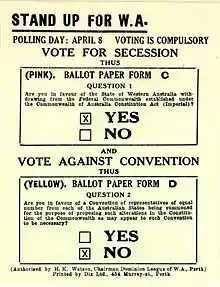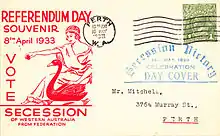1933 Western Australian secession referendum
A secession referendum was held on 8 April 1933 in the Australian state of Western Australia, on the proposal that the state withdraw from the Australian Federation.[1] The proposal won a majority of the votes and a petition to give effect to the decision was subsequently sent to the British Parliament, where a parliamentary joint select committee ruled it invalid.

Questions
Two questions were voted on at the referendum:
- Question 1: Are you in favour of the State of Western Australia withdrawing from the Federal Commonwealth established under the Commonwealth of Australia Constitution Act (Imperial)?
- Question 2: Are you in favour of a Convention of Representatives of equal number from each of the Australian states being summoned for the purpose of proposing such alterations in the Constitution of the Commonwealth as may appear to such Convention to be necessary?
There were 237,198 registered voters. The result on the first question was 138,653 in favour and 70,706 against. Question Two was rejected by a vote of 119,031 to 88,275.[2] Only six of the fifty electoral districts recorded a No vote on the first question, five of them being in the Goldfields and Kimberley regions.[3][lower-alpha 1]
| Question | Yes | No | ||
|---|---|---|---|---|
| Votes | % | Votes | % | |
| 1. Western Australia withdrawal from Commonwealth of Australia | 138,653 | 66.23% | 70,706 | 33.77% |
| Metropolitan[lower-alpha 2] | 72,037 | 64.85% | 39,043 | 35.15% |
| Agricultural[lower-alpha 3] | 57,316 | 72.89% | 21,319 | 27.11% |
| Mining and Pastoral[lower-alpha 4] | 7,763 | 45.55% | 9,279 | 54.45% |
| Northern[lower-alpha 5] | 1,537 | 59.07% | 1,065 | 40.93% |
| 2. Australian states' constitutional convention | 88,275 | 42.58% | 119,031 | 57.42% |
| Metropolitan[lower-alpha 2] | 48,066 | 43.75% | 61,821 | 56.26% |
| Agricultural[lower-alpha 3] | 29,509 | 37.90% | 48,348 | 62.10% |
| Mining and Pastoral[lower-alpha 4] | 9,271 | 54.70% | 7,677 | 45.30% |
| Northern[lower-alpha 5] | 1,329 | 51.04% | 1,275 | 48.96% |
Aftermath

The Constitution of Australia, which established the Australian federation in 1901, had originally been an act of the British Parliament, and a petition was sent to it from Western Australia, asking that the Australian Constitution be changed to give effect to the separation vote. A joint select committee was set up by the British Parliament to consider the petition, and it decided that the request could not be acted upon because it did not have the support of the Australian federal government, as required by the 1931 Statute of Westminster.[5]
Pressure for any further action was reduced by the victory of the anti-secession Labor Party in the Western Australia state election which was held on the same day as the referendum. The establishment of the Commonwealth Grants Commission in May 1933 helped alleviate some of the grievances that had motivated the secessionist movement.[6]
Legacy
In the many decades after the 1933 referendum, it is invoked when Western Australian industry groups publicly complain about issues with the federal government in Canberra.[7]
See also
Notes
- The electoral districts to vote no were: Boulder; Brownhill-Ivanhoe; Hannans; Kalgoorlie; Kimberley; Murchison.[4]
- Metropolitan: Canning; Claremont; Fremantle; Fremantle NE; Fremantle S; Guildford-Mid; Leederville; Maylands; Middle Swan; Mt Hawthorn; Nedlands; Perth; Perth E; Perth N; Perth W; Subiaco; Victoria Park.[4]
- Agricultural: Albany; Avon; Beverley; Bunbury; Collie; Forrest; Geraldton; Greenough; Irwin-Moore; Katanning; Mt Marshall; Murray-Wellington; Nelson; Northam; Pingelly; Sussex; Swan; Toodyay; Wagin; Williams-Narrogin; York.[4]
- Mining and Pastoral: Boulder; Brownhill-Ivanhoe; Hannans; Kalgoorlie; Kanowna; Mt Magnet; Murchison; Yilgarn.[4]
- Northern: Gascoyne; Kimberley; Pilbarra; Roebourne.[4]
References
- "1933—Secession Referendum". Western Australian Electoral Commission. Archived from the original on 18 May 2015.
- Musgrave, Thomas. "The Western Australian Secessionist Movement". Cite journal requires
|journal=(help) (2003) 3 Macquarie Law Journal 95. Retrieved 12 October 2009 - Stannage, C.T., ed. (1981). A New History of Western Australia. University of Western Australia Press, Nedlands. p. 422. ISBN 0-85564-181-9.
- "The Referendum". The West Australian. 3 May 1933. p. 14 – via National Library of Australia.
- "W. A. Secession". The Mercury. Hobart, Tas. 25 May 1935. p. 14. Retrieved 9 April 2012.
- "Giblin's Platoon". ANU EPress. 2006. Retrieved 23 September 2014.
- "Miners talk secession, recalling the heady times of 1933". theAge.com.au. 30 June 2011.